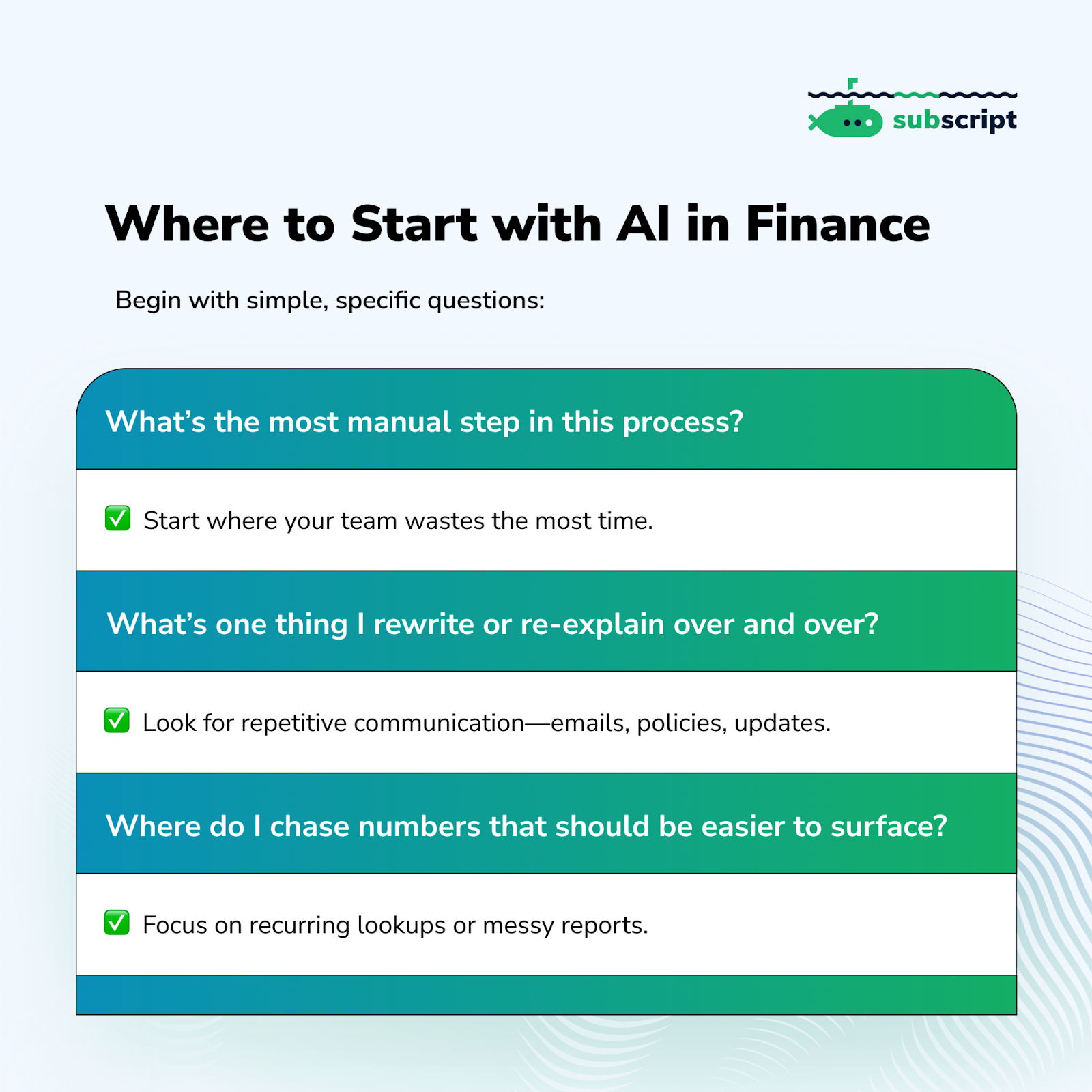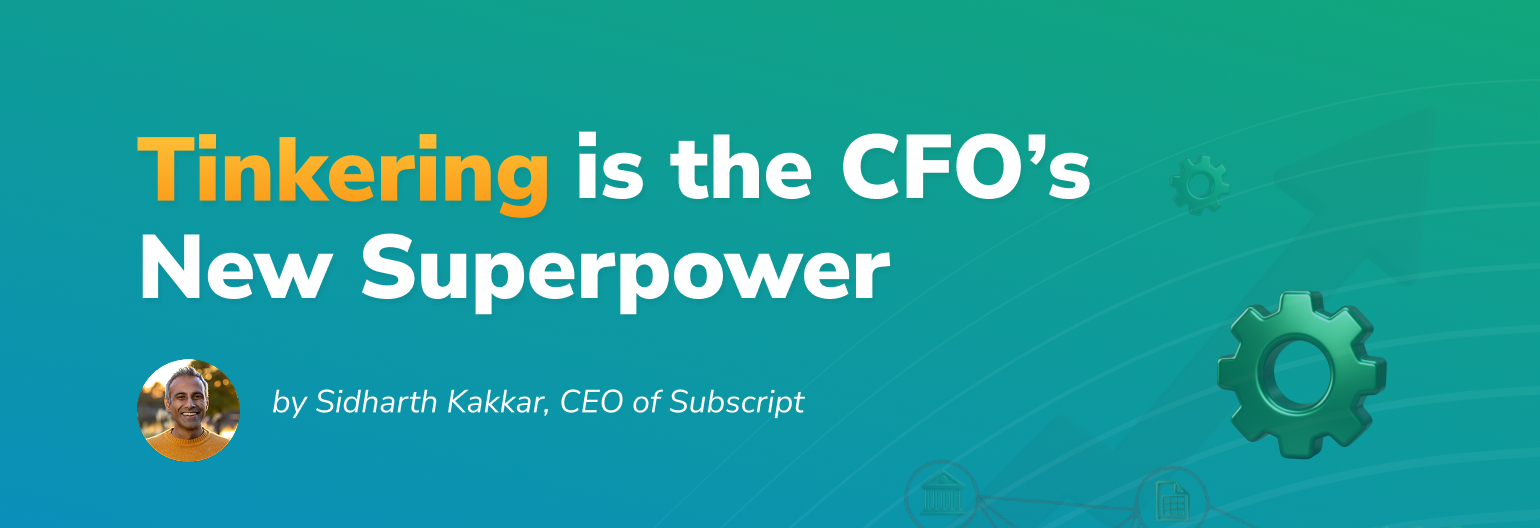Most CFOs I’ve spoken with in the past 3 months are under some kind of AI mandate, with pressure from the board or CEO to find more efficiency. In theory, everyone agrees that AI should drive productivity, but most finance leaders are still skeptical. They’ve been promised “AI magic” too many times. The tools feel early—and yet, the pace of improvement is impossible to ignore.
The next generation of tools will be far more capable. By the end of this year, the real advantage will go to the teams who’ve been hands-on early—who’ve built up instincts, spotted patterns, and refined their judgment by testing the tools at their disposal today. They’re not waiting for an all-inclusive solution. They’re tinkering with AI, even if the results are a little rough around the edges.
So, how do you prepare your finance team for AI that’s improving every quarter?
⚙️ You start by developing a tinkerer’s mindset.
The Tinkerer’s Mindset
Tinkering isn’t just chasing shiny tools. The goal is to create your own working intuition for what large language models (LLMs) are good at, where they fall short, and how they fit into your team’s unique business context.
You might have imagined full-blown automations replacing old processes end-to-end. But what you’ll likely discover instead are small, surprising wins: One LLM that drafts an internal policy more clearly than you can or another that flags churn anomalies you hadn’t noticed manually.
These results aren’t flashy. But they make your day-to-day life easier. And the more reps you get, the more AI fluency you’ll have. That fluency is what separates a passive observer from a confident operator.
Find the Smallest Win
You don’t need to spin up a task force or organize a hackathon. Take a lighter approach: ask your team to take product demos—not to purchase anything, but to see what’s possible. Or have each person list the most manual, repetitive items in their to-do list. Then pick one that doesn’t involve sensitive data and try to automate it.
Adopting AI isn’t like migrating to a new ERP. You don’t need a big rollout. You just need a few places to test it out. Don’t try to streamline everything at once. You can develop your instincts, one focused experiment at a time.

You Don’t Need Perfect Data
Many CFOs assume they need a pristine data environment before exploring AI. But that’s backwards.
Large language models don’t require clean naming conventions or centralized databases to be useful. LLMs can handle the mess. They’re shockingly good at navigating the chaos most finance teams live with—clunky spreadsheets, disjointed tools, inconsistent field names, missing metadata, you name it.
That doesn’t mean data hygiene doesn’t matter, but it does mean you can start now.
LLMs are built to work with what you’ve got. They don’t replace your systems. They layer into them.
Worried about Data Security?
“Can I even put this data into an AI model?”
It’s a good question—and the answer is, sometimes.
You don’t want to upload contracts or customer PII into the free version of ChatGPT. But enterprise-grade LLM models now offer zero data retention, SOC 2 compliance, and private instances.
If your company hasn’t rolled those out yet, you can still move forward. Use dummy data and redacted docs, or focus on internal-only workflows that don’t touch sensitive information.
You don’t have to bet the farm. Safe experiments today will make you a more savvy buyer when it’s time to evaluate tools with stricter guardrails.

Use Multiple Tools
Every LLM has its strengths—and you won’t notice the differences until you compare them side by side. Try feeding the same input into each tool and watch how they handle it.
Here’s a quick guide:
- ChatGPT by OpenAI - Great for technical writing and analytical tasks
- Claude by Anthropic - Strong at narrative summaries and human-sounding output
- Gemini by Google - Excels with structured data and integrates well with Google tools
- Perplexity - Best for citation-backed research and fast, reliable fact-checking
Of course, the quality of the output often depends on how you submit the request. Even if you never write code or build a workflow, learning to prompt effectively (what context to include, how to phrase the question, when to iterate) is a skill worth honing.
🤔 Curious What Else is Out There?
Try other AI tools, too. They don’t have to be finance-specific. For example, in the last few months, I’ve been testing Granola for meeting transcription. Using a range of tools helps refine your sense of what good output looks like.
Don’t Wait for the Ideal Solution
Behind the scenes, a lot of CFOs are asking: When will this stuff actually work? Can’t I just hold off until there’s a clear winner? The truth is: most AI tools for finance are underwhelming. The hype is out ahead of the capabilities. But the speed of change is staggering, and the only way to keep up is to get your hands dirty.
You may not buy the hype now, but odds are you’ll be evaluating AI vendors before long. And your evaluation criteria will be more precise if you know what problems you want to solve, what interfaces you prefer, and how to recognize high-quality output.
Can’t I Just Hire Someone to Figure This Out?
Maybe you’re thinking: I’m busy. I’m not technical. I’m not close to the details.
And that’s fair. Not every finance leader wants to be in the weeds. But even if you delegate AI discovery, it’s still worth spending some time in the tools yourself.
🕙 Just an hour a week can improve your judgment, strengthen your partnership with more technical contributors, and boost your credibility when it’s time to invest.
That said, if you’re hiring someone to run with AI exploration—or empowering someone internally—here’s what to look for:
Signs of a strong AI tinkerer
- Comfort with ambiguity and early-stage tools
- Past experience automating workflows (Excel, Notion, Zapier, etc.)
- Systems thinker—interested in how things fit together, not just the final output
- Strong intuition around data structure and business logic
- Hands-on familiarity with tools like ChatGPT, Claude, or Gemini
- Technical abilities (Python, SQL, etc.) are an added bonus
You don’t need a machine learning engineer. You need someone close enough to the work to know where the friction is, and driven enough to fix it.
Using AI is Like Strength Training: Put Your Reps In
Tinkering might feel unproductive, but it’s actually a shortcut to building instincts. If you’re not guessing what you need, you’ll be ready when the next wave of functionality lands.
If I were a CFO at a $10M+ ARR SaaS company, I’d set three resolutions for the rest of this year:
- Take every demo you can—not to buy, but to pattern match
- Use ChatGPT, Claude, or Gemini every day
- Pick one annoying task and try to solve just that with AI
The future isn’t fully here yet, but the finance teams who’ve gained some internal muscle through tinkering with AI will be in much better shape to spot the best tools and know how to use them effectively.
Curious how AI could work inside your finance team? Let’s trade notes.
%20(2).svg)

.svg)
.svg)




.svg)





.svg)


.svg)







